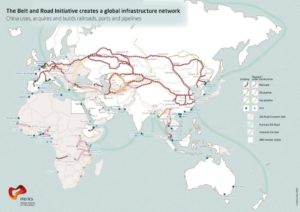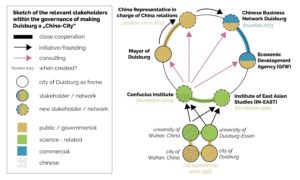Elisabeth Kaufmann, BSc, (top left) is a postgraduate student of Spatial Planning at the Technical University of Dortmund. She has been student assistant at the Chair of International Planning Studies between April 2019 and March 2020, and currently is undertaking an internship at the Gesellschaft für Internationale Zusammenarbeit (GIZ) in the project “Sino-German Cooperation on Mobility and Fuels strategy”.
Dr. Franziska Sielker (mid left) is a Lecturer for Planning and Housing at the Department of Land Economy at the University of Cambridge, and was formerly Interim Head of the Chair of International Planning Studies at the Faculty of Spatial Planning, TU Dortmund University.
Robin Chang, BPl, MSc, (bottom left) is Research Associate and Instructor at the Chair of European Planning Cultures at the Faculty of Spatial Planning, TU Dortmund University. Her PhD research examines adaptive mechanisms and stabilization processes through temporary uses in the context of urban regeneration. Prior to starting her work in Dortmund, she studied environmental planning and practices land use planning in British Columbia (CA).
The Chinese Belt-and-Road-Initiative (BRI), announced in 2013 by the Chinese President Xi Jinping, aims to foster economic relationships through connectivity. The size and ambition of the BRI is unprecedented: it spans across more than 120 countries and is ratified by more than 170 “Memorandum of understandings” (Website YiDaiYiLu 2020), and aspires to provide better infrastructure linkage through six ‘economic belts’ across land and two sea corridors (the 21st Century Maritime Belt and the Maritime Polar Silk Road) (cf. Figure 1). The main land ‘economic belt’ of relevance to Europe is the New Eurasia Land Bridge Corridor. It promises European cities the opportunity to participate in new global trade routes. Prominent examples of cities that have received major Chinese investments are Piraeus (Greece), Trieste (Italy), Kirkensens (Finland) and Duisburg (Germany). Taking the latter as an example, we ponder how interwoven Duisburg’s city governance is today with Chinese collaborations. The Duisburg example illustrates the depth of change the BRI has inflicted on urban governance after a decade of close collaboration, while transport connectivity and logistics under the guise of the BRI played an important initial narrative.
Figure 1. Geographical coverage of the Belt and Road Initiative (Metrics Research, 2018).

Located in the Rhine-Ruhr metropolitan region, Duisburg is a strategic transport hub, with its harbour serving as a BRI node since 2011. Similar to the Ruhr region, Duisburg’s economic development changed following the decline of coal production in Germany, and the city still suffers from the legacies of economic and structural setbacks. In response, the municipality set upon a path directed by three dimensions: steel production, logistics and Chinese Investment. Currently, one third of all employees in Duisburg are employed (in)directly at the harbour and its logistics connections (Deutschlandfunk Kultur 2018, Agentur für Arbeit 2019). We argue that through a focus combining the logistics sector, and the Sino-German cooperation, a new economic reliance, as opposed to economic relationship, is developing.
Duisburg and its ties to China
Since the initiation of the first Sino-German partnership between Duisburg and Wuhan in 1982, the cultural and economic cooperation of the two cities continues to grow steadily. Fueled by the BRI-related visit of Xi Jinping to the Duisburg harbour in 2014, hopes were raised about the possible economic boosts from even closer ties with China, prioritizing Chinese investments as a part of the city’s urban development aims:
“China is a real diamond for Duisburg. We want to continue working on this with verve and commitment.” (Mayor Sören Link in Deutschlandfunk 2018, own translation)
City officials now market Duisburg as the ‘German China City’. The goals are to profit from economic spillovers, increase tax income through Chinese workers, students and migrants living in Duisburg, and to attract new Chinese firms to create jobs for Duisburg’s citizens.
Duisburg’s changing governance – a new Sino orientation or slant?
Since the current mayor took office in 2012, the acceleration of China-related activities has changed in urban governance. Figure 2 illustrates Chinese affairs related stakeholders in Duisburg and their interactions. These relationships underline a growing interdependency of the actors and tighter associations that share the same goal: to make Duisburg attractive through, and for Chinese Investment.
Figure 2. Chinese affairs related stakeholders in Duisburg and their interactions with one another (Adjusted translation from Kaufman, 2019).

In 2013, the expanding importance of China was manifested by putting in place a specific China representative in the public administration, who is in charge of China relations, and the creation of a Chinese Business Network.
Most notably in 2013, the public administration created a China-specific position in charge of China relations. Not only does the person have access to any necessary department heads from the city administration, the person is also the mayor’s proxy in China-related negotiations. To support this leadership role, the Chinese-Business-Network-Duisburg was created to gather and share information in the interest of promoting Chinese economic activity. According to city officials, a vital agency is the Confucius Institute, which serves through consulting expertise in Chinese language, interpreting, culture and business-making. To integrate and direct all of these positions and relationship, the city developed a “China-strategy”, which was supposed to be implemented in 2020, and identifies the (planning) instruments and resources needed to make Duisburg more appealing to Chinese companies as a place for investment and destination for emigration. In comparison to other German cities with Chinese ties, Duisburg’s integrative and new governance structure punctuates the municipality’s extraordinary orientation towards Chinese interests through BRI projects and processes. While fostering China-led cooperation, Duisburg’s urban development strategy, as illustrated here, also creates new economic dependencies.
Outlook
Until now, Duisburg prospered from the decision to amplify their established and strong connection to China. Reaping benefits from this commitment, however, also means that the city is subjecting itself to the increasing influence of one singular state. Whether or not the equal footed relationship is slipping into a situation of Duisburg versus Goliath, is not openly nor critically reflected at this point. It remains to be seen to what extend the trade route contributes to an increase in trade volume and to what extent this translate to a wider economic growth in Duisburg and its surroundings. More widely, local administrations lack coherent expectations what to gain from investments while considering the inherent risks. Cities could more critically consider how they set up the urban governance to step into negotiations with the economic Goliath represented by China. While the example of Duisburg indicates that a Sino-orientation is beneficial and increases cooperation, other stakes may fall under the table. This research hence prompts cities to question how to benefit from Chinese benevolence, ensure long-term resilience, and prevent a Duisburg and Goliath situation from sneaking up behind.
Note
This post is based on research that has been conducted at the International Planning Studies Department of the TU Dortmund, Germany and draws on Elisabeth Kaufmann’s undergraduate research “Duisburg und der Duisport Hafen im Spannungsfeld zwischen chinesischer Außenpolitik und lokaler Wirtschaftsentwicklung” (thesis submitted in German language in December 2019, supervised by Dr. Franziska Sielker and Robin Chang).
References
Agentur für Arbeit (2019): „Jahresbilanz 2018 zum Arbeitsmarkt im Bezirk der Agentur für Arbeit Duisburg“. Available on https://www.arbeitsagentur.de/vor-ort/duisburg/content/1533715006197 (accessed on 09.04.2020).
Deutschlandfunk (2018): „Neue Seidenstraße: China bringt Duisburg mehr als nur“. Published 08.02.2018, available on https://www.deutschlandfunk.de/neue-seidenstrasse-china-bringt-duisburg-mehr-als-nur.862.de.html?dram:article_id=410302 (accessed on 07.04.2020).
Deutschlandfunk Kultur (2018): „Strukturwandel im Ruhrgebiet: Duisburg gibt nicht auf“. Published 12.06.2018, available on https://www.deutschlandfunkkultur.de/strukturwandel-im-ruhrgebiet-duisburg-gibt-nicht-auf.976.de.html?dram:article_id=420198 (accessed on 07.04.2020).
Handelsblatt (2018): „Ausbaupläne Chinatown Duisburg – Wie das Ruhrgebiet von der Seidenstraße 2.0 profitieren will“. Published 24.09.2018, available on https://www.handelsblatt.com/politik/international/ausbauplaene-chinatown-duisburg-wie-das-ruhrgebiet-von-der-seidenstrasse-2-0-profitieren-will/23098358.html (accessed on 04.04.2020).
Kaufmann, Elisabeth (2020): „Duisburg und der Duisport Hafen im Spannungsfeld zwischen chinesischer Außenpolitik und lokaler Wirtschaftsentwicklung.“ Thesis submitted for Degree of BSc at TU Dortmund University, supervised by Dr. Franziska Sielker (University of Cambridge) and Robin Chang (TU Dortmund), for a copy please contact Elisabeth.kaufmann@tu-dortmund.de
Merics research (2018): “Silk Road overview” Available on https://www.merics.org/sites/default/files/2018-06/MERICS_Silk_Road_v8.jpg (accessed on 04.04.2020).
Website YiDaiYiLu (2020): https://eng.yidaiyilu.gov.cn/qwyw/rdxw/81686.htm (accessed on 04.04.2020)
Are you currently involved with regional research, policy, and development, and want to elaborate your ideas in a different medium? The Regional Studies Association is now accepting articles for their online blog. For more information, contact the Blog Editor at RSABlog@regionalstudies.org.